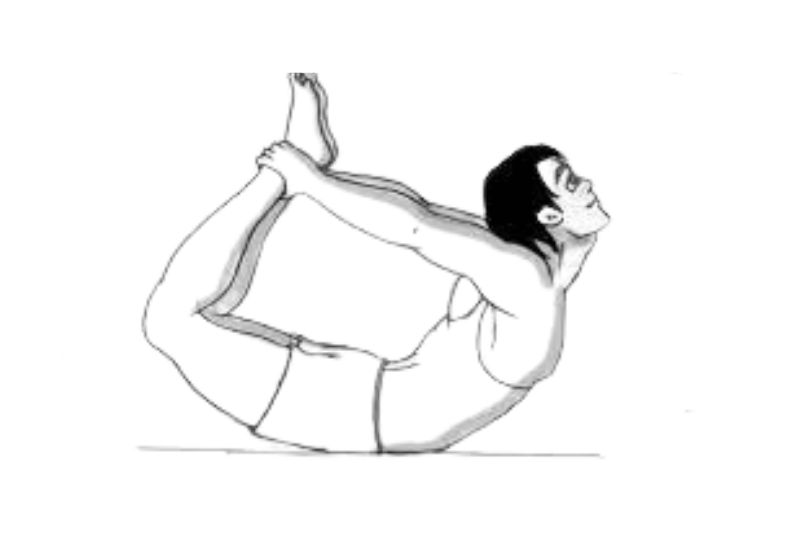Looking for a straightforward yet potent yoga practice to increase your flexibility and fortify your back muscles? The Easy Bow Pose, also known as Saral Dhanurasana, is the only pose you need. This restorative pose has a wealth of advantages for the body and mind. In this post, we will study the methods to complete Saral Dhanurasana, delve into its incredible benefits, and address measures to maintain a safe practice. So, let’s dig in and unveil the secrets of Saral Dhanurasana!
A yoga position called Saral Dhanurasana has the appearance of a bow. It entails gently and deliberately bending the back, much like the drawstring of a bow. Sanskrit’s “saral” (which meaning “easy”) denotes how simple and approachable this stance is. Let’s examine the procedures, advantages, and safety measures for performing Saral Dhanurasana:
Steps to Perform Saral Dhanurasana (Easy Bow Pose)
Saral Dhanurasana is a gradual process that calls for concentration, equilibrium, and body awareness. To easily perform this pose, follow these steps:
Start in a prone position: Your feet should be hip-width apart, and your arms should be by your side as you lay flat on your stomach.
Bend your knees: Gently bending your knees will allow you to raise your heels up to your buttocks.
Reach back: Depending on your flexibility, reach back with your hands and grip either your ankles or your feet. Make sure your grip is relaxed.
Inhale and lift your chest: Take a big breath in, and then lift your chest off the mat. Make an effort to open your heart centre and stretch your spine.
Lift your thighs: As you continue to inhale, push your thighs off the mat by relying on the power of your back muscles. Keep your movement controlled and gentle.
Keep your gaze forward: Keep looking forward. In order to prevent neck strain, fix your gaze forward. Continue to breathe in a steady, unhurried manner.
Hold the pose: Hold the pose for 15 to 30 seconds, or however long feels comfortable. Increase the duration gradually as you get better at practising.
Release and relax: Release your hold on your ankles or feet and breathe out slowly. Bring your thighs and chest back to the mat. Consider lying down and paying attention to your body’s feelings.
Congratulations! Saral Dhanurasana (Easy Bow Pose) was performed correctly by you. Repeat this series a few times to gradually increase your flexibility and strength. After going over the instructions, let’s explore the amazing advantages of performing this stance.
Benefits of Saral Dhanurasana (Easy Bow Pose)
Enhances spinal flexibility: Improves spinal flexibility by gently stretching the entire back in Saral Dhanurasana. This posture increases mobility and flexibility. Regular practise helps promote a healthy and flexible spine by reducing back pain and stiffness.
Strengthens back muscles: The erector spinae and rhomboids, as well as other back muscles, are the focus of this pose. Saral Dhanurasana assists in strengthening and toning these muscles, improving posture and lowering the risk of back-related injuries.
opens the chest and shoulders: In Saral Dhanurasana, your chest and shoulders are gently stretched and opened as you lift your chest off the mat. This promotes improved respiratory function and a greater sensation of openness while working to counterbalance the negative consequences of slouching and hunching.
Improves digestion: The liver, kidneys, and intestines are among the abdominal organs that are massaged by Saral Dhanurasana’s bow-like structure. This stimulation improves digestion, controls metabolism, and encourages cleansing, improving digestive health in general.
Boosts energy and vitality: Saral Dhanurasana’s dynamic style enhances the body’s energy flow. This energizing position will help you feel more energized and refreshed by reducing fatigue, boosting vitality, and lifting your mood.
Stimulates the reproductive system: Easy Bow Pose stimulates the reproductive system by giving the reproductive organs a gentle massage that encourages healthy blood flow and hormonal balance. For females who experience menstruation discomfort or abnormalities, this may be especially helpful.
Relieves stress and anxiety: Relaxation and tranquility are brought on by practicing Saral Dhanurasana, which stimulates the parasympathetic nervous system and relieves tension and anxiety. You may feel more at ease and relaxed as a result of this since it can help you cope with stress, worry, and tension.
Enhances body awareness: Saral Dhanurasana cultivates body awareness through the deliberate use of different muscles and the emphasis on alignment. This increased awareness can benefit your posture, mobility, and general physical well-being even outside of your yoga practise.
Promotes self-confidence: Strength, flexibility, and a sense of success are all gained as you gradually advance in the practise of Saral Dhanurasana, which boosts your self-confidence. This can help you feel more self-assured both on and off the yoga mat, enabling you to handle difficulties with poise and resilience.
Cultivates patience and perseverance: teaches patience and perseverance because Saral Dhanurasana takes both to be mastered. You develop the ability to embrace the journey rather than concentrating just on the outcome through constant practise. This develops virtues like self-control, self-discipline, and patience.
After exploring the many advantages of Saral Dhanurasana, it is crucial to remember a few safety measures to guarantee a successful practise.
Precautions for Practicing Saral Dhanurasana (Easy Bow Pose)
While most people may safely perform Saral Dhanurasana, it is still important to approach the position carefully and pay attention to your body’s limitations. Precautions should be taken before practicing including:
Consult a healthcare professional: Saral Dhanurasana should not be attempted if you have any pre-existing medical concerns, such as spinal injuries, herniated discs, or recent operations. It is recommended that you speak with a healthcare provider before attempting this pose. They can offer you personalized advice based on your unique needs.
Warm-up adequately: Make sure your body has been warmed up with easy stretches and movements before attempting Saral Dhanurasana. Your muscles, joints, and spine are prepared for the deeper backbend thanks to this.
Modify as needed: If you have trouble reaching your ankles or feet, try using a strap or a towel that has been folded to fill the space. Your hands should be firmly grasping the strap as you loop it around your ankles.
Listen to your body: Always pay attention to your body’s signals; never push it past its breaking point. Respect your flexibility’s limits and only extend it as far as it is comfortable for you. Injury can result from straining or overextending.
Avoid if pregnant: Saral Dhanurasana requires a deep backbend and pressure on the abdomen, which may not be safe to perform when pregnant. If you are expecting, it is better to avoid doing Saral Dhanurasana. However, always consult with your healthcare physician for personalized advice.
Breathe smoothly and rhythmically: Hold the stance while keeping your breathing steady and calm. Avoid holding your breath or breathing shallowly. You may maximise the advantages of the pose by engaging in deep, mindful breathing that keeps you in touch with your body.
Be aware of neck strain: Keep your neck in a neutral position and avoid putting it under too much strain or tension. Instead of craning your neck backward, focus on elevating your chest and arching your upper back.
Remember, practicing Saral Dhanurasana should be a joyous and uplifting experience. Pay attention to your body’s signals, respect its limitations, and adjust as necessary. Let’s now discuss some of the often-asked questions regarding Saral Dhanurasana.
FAQs About Saral Dhanurasana (Easy Bow Pose)
1. Is Saral Dhanurasana suitable for beginners?
Absolutely! Saral Dhanurasana is considered a beginner-friendly pose. To prevent strain or damage, it’s crucial, to begin with tiny motions and progressively widen your range of motion. To guarantee proper alignment and changes, get advice from a certified yoga teacher.
2. How often should I practice Saral Dhanurasana?
Depending on your personal objectives and comfort level, you should practice frequently. To reap the benefits, try to consistently practice two to three times per week. You can include it into your normal yoga program as you gain more skills.
3. Can Saral Dhanurasana help with weight loss?
Saral Dhanurasana is not a specific weight loss exercise, but it does activate a number of muscles and enhance general body tone. Regular practice of yoga, particularly Saral Dhanurasana, along with a balanced diet and an active lifestyle, can contribute to weight management and overall well-being.
4. Can Saral Dhanurasana relieve menstrual cramps?
Yes, Saral Dhanurasana can ease the pain associated with menstruation. To relieve cramps and encourage healthy blood flow, the abdomen region can be gently compressed and stimulated. Individual experiences may differ, so pay attention to your body and adjust the pose as necessary.
5. Can I practice Saral Dhanurasana if I have lower back pain?
Saral Dhanurasana should only be performed with extreme caution if you suffer from lower back pain. Consult a medical expert or a certified yoga instructor who can show you the proper adjustments and changes to meet your situation. You should put your safety first and avoid any moves that make your pain worse.
6. Can Saral Dhanurasana improve posture?
Yes, Saral Dhanurasana can help with better posture by bolstering the back muscles and expanding the chest. You are likely to see improvements in your posture as you gain stronger body awareness and core stability through consistent practice.
It’s time to include the restorative posture Saral Dhanurasana (Easy Bow Pose) in your yoga routine now that you fully comprehend all of its components, advantages, safety precautions, and commonly asked concerns. Take advantage of Saral Dhanurasana’s journey of self-discovery and transformation.
Yoga Teacher Training in India – Aerial Yoga Teacher Training in India – Kundalini Yoga Teacher Training in India – Ayurveda Yoga Teacher Training in India – Multi Style Yoga Teacher Training in India – Ashtanga Yoga Teacher Training in India




